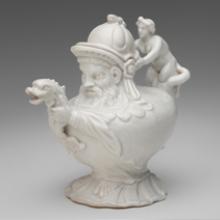
It never ceases to amaze me the volume of porcelain Meissen produced during their first forty years of production. Considering rarities are still turning up at auctions in both the major and minor salesrooms everywhere.
In one way Meissen was emulating the Chinese; the only difference being porcelain production in China was on a far vaster scale with far more potters; in fact thousands more since in China porcelain production was focused in Jingdezhen where there were an army of potters. Quite a diverse force of porcelain production than that at Meissen. Nevertheless the production at Meissen was huge and the modellers and painters found a way to churn out huge quantities for a very demanding customer base. This being much of European aristocracy and royalty as well as other merchants.
A visit to the Meissen Museum, the Zwinger in Dresden, the Victoria and Albert Museum in London, the Rijksmuseum Amsterdam, the many other museums dotted around Europe and the UK. Travel across to the US. The Outstanding collections at the Met New York, The Art Museum Seattle, San Francisco Airport Museum, the Wark Collection at the Cummer Museum Jacksonville and other countless state side museums. Travel over the border to Toronto and you will see some other great pieces. The list is almost endless where you can find the rarest and most exciting pieces of 18th century Meissen. The following is just a small selection from some of these museums collections of Meissen. Each of the pieces chosen will have their own individual uniqueness
Philadelphia Museum of Art.
A particular object in Meissen porcelain that I rarely owned and if I did for a very short time was a Lithophane. While being very rare they are only sought after by the very specialist collector. I like the way this one is mounted.
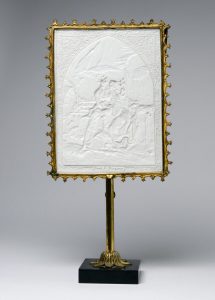
Not all of Meissen has to be very early to be unique. During my career of buying and selling from time to time I come across pieces of Meissen I have never seen before. I have only made a short fleeting visit to the Philadelphia Museum of Art so didn’t take too much notice of all the individual rarities. However this was one whose shape I have never seen before. It was made towards the end of the 18th century in the Marcolini Period. For me it is an exception and creative object. A teapot whose spout imitates an exotic bird possibly an eagle. The scene painted is a gallant with his lover conversing with a friend. The decoration although very plane sits well on the white background.
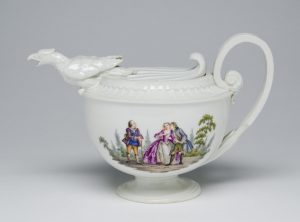
I always marvel at the stoneware creations of Bottger. A hexagonal tea caddy circa 1710-13 painted with a floral design after the Chinese
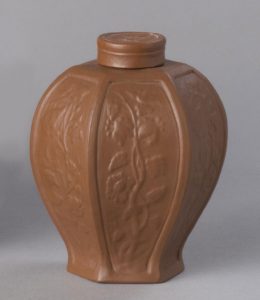
The Wark Collection Courtesy of the Cummer Museum Jacksonville
Comprises of 700 pieces mainly service wares and is possiblythe finest of its type in the US.
The following two items illustrated although very diverse are rare and unique in their own right. The first is a spectacular garniture of vases by Johann Gregorius Höroldt made for Augustus the Strong, Elector of Saxony and King of Poland. The vases were made to sit on a mantle piece. The vases show various patterns, including one scene depicting the Chinese imperial couple seated and drinking tea. Overhead are a flying dragon and flying phoenix, symbols of the emperor and empress of China; circa 1728-30
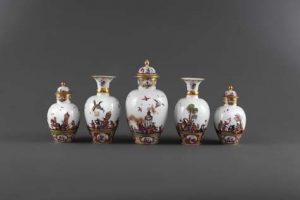
This very rare pair of Meissen tea bowls hold onto an interesting story. As the Meissen Porcelain Manufactory gained more success, it looked to broaden its reach outside of Europe. These saucer-less tea bowls were made for the Turkish market around 1756. An Arabic inscription along the rim proclaims, “Ah, how beautiful, may it taste good to the drinker.” Below, stylized lotus flower petals in blue, green, and purple are stippled with dots. In later shipments to Turkey, Meissen opted to alter its noted crossed swords logo with pseudo-Chinese characters because they feared their trademark might look too much like the Christian cross for some buyers.

The Met Museum New York.
Early Meissen Bottger period Stoneware Kendi. The form is derived from a Southeast Asia pouring vessel loosely originating earlier in India. The Kendi is circa 1710-12.
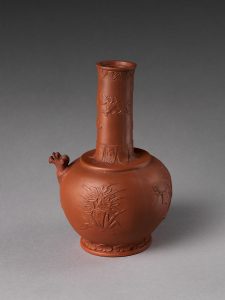
A fine and early Meissen example of an Italian Comedy Group: Pantaloone and Columbine circa 1736 modelled by Johann Joachim Kändler after a composition by Jacques Callot (French, Paris 1592-1635) engraved by Joullain. What makes this group special is the lack of floral work that can be seen on similar models made a few years later. White based groups that fall into this early category are far rarer than later Kändler models.
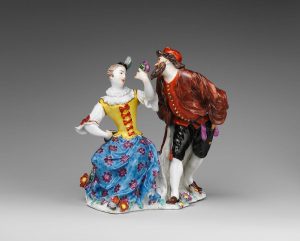
An exceptionally and rare early Meissen Johann Gregorius Horoldt (1696–1775) period teapot circa 1722. The underside of the teapot is marked M.P.M. (Meissener Porzellan Manufaktur), a mark that appears to have been in use only for a few months in autumn 1722, although the decoration may have been applied during the course of the following year. While Horoldt is best known for the chinoiserie scenes that he both painted and promoted as a principal category of decoration in the 1720s, but some of the earliest compositions painted under his direction depict European subject matter.
The two reserves, as well as the lid of the Museum’s teapot, depict dwarfs at a riding school, and all of the figures are taken from a series of prints about a riding school for dwarfs.
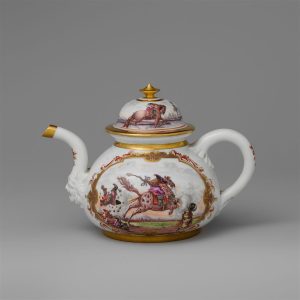
An early Kändler figure of a Macaw circa 1731. The majority of Kändler bird figures seen are circa 1740. This make this Macaw a very rare example. Some of the later Kändler models are seen with raised foliage around the base.

Seattle Art Museum
Its wonderful to see three different version of Bottger porcelain and Stoneware in one display. These tea caddies were made between 1715 and 20. As seen they are in red stoneware, black and gilded stoneware and white porcelain. All three pieces have raised decoration.
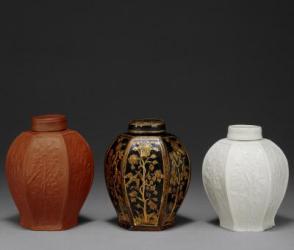
Meissen Tobacco Box 14cm wide circa 1750
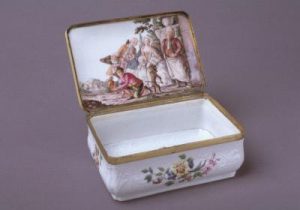
This sugar bowl comes from a service for Heinrich Podewils (1695–1760). He was made a count in 1741 and was prime minister to Frederick the Great of Prussia.
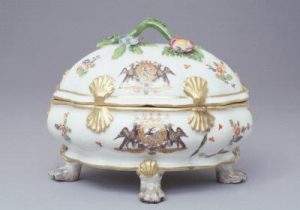
Undoubtedly one of the finest collections of Meissen porcelain in private hands can be found at the International terminal San Francisco Airport. It is a must see for anyone passing through the airport; even if you arrive at another terminal it is worth a look. Malcolm Gutter’s collection defies belief. I fist visited Malcolm’s home before he lent the collection to the museum on a permanent basis. It is Malcolm’s lifetime ambition to create such an extraordinary collection of early 18th century Meissen few other collections can compete with. I also have met up with Malcolm during his numerous visits to London for the summer antique fairs and lectures. Hopefully these will return in 2022.
The following is a Blan de Chine Teapot; (the name Blan de chine is derived from early Chinese ceramics meaning white).
This teapot is of the rare grotesque form and was made circa 1719-20. It is amongst the most outrageous of Böttger’s designs inspired from the engravings in Litre de Vases (Paris 1667) from the designer Jacques Stella (1596–1657).

Early 18th century Meissen blue and white was extremely fashionable and sought after during the period of manufacture 1722-23. This was in part that it copied the Chinese Porcelains of the Kang Hsi period also the shape; grand baluster vase (yen Yen is comparable in importance to the best blue-and-white creations of the Yuan and early Ming period. The intricacy of the painting was considered to match the finest porcelains the Chinese could produce during the period. It is based upon a classic Chinese baluster shape (yenyen), which dates to the Song period. The decoration is most likely by Johann Caspar Ripp, who came to Meissen in 1721, as an experienced painter of German faience (earthenware).
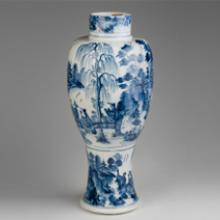
The dish below from the Swan Service with arms of Brühl and Kolowrat-Krakowska c. 1738-39 has a most remarkable story attached to it.
The service originally comprised of more than 2200 pieces and was meant to be for 100 people. It was considered the most lavish and opulent service ever made complete with many figural designs. The service was commissioned in 1737 by Count Heinrich von Brühl, Prime Minister under King Augustus III and later head supervisor of the royal porcelain manufactory. It took in all five years to complete.
The Brühl family owned the service until World War II. It was thought leaving the major pieces in a safe would protect it from any harm. Sadly after the war, when the Soviets invaded Poland, much of the service was pilfered from the palace and some of the pieces were used as target practice. While many of the pieces were sold to private collectors and museums outside of the country fragments of broken pieces have turned up at major auctions from time to time selling for hundreds or thousands of pounds.
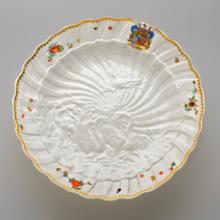
While I not visited every major museum in North America The Gardiner Museum in Toronto is one that I have visited several times since it houses an outstanding collection of the rarest of early 18th century Meissen Porcelain. The following are just a small selection.
While there are many examples of complete Meissen tea sets what there are not are tea sets complete with their travelling cases. Yellow ground is one of the more sought after ground colours that makes this set more exciting circa 1740.
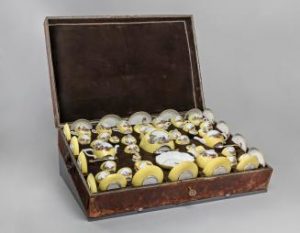
Throughout Meissen’s history there has been interest is acquiring the most extravagant and lavish models money could buy. This royal hunting clock circa 1732-33 made for Augustus III is such an example.
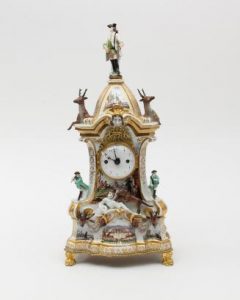
Not all of Meissen rarities are large but miniature such as this thimble circa 1740 show intricate painting in a small size.
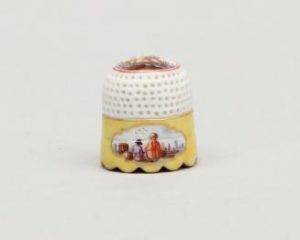
More images of fine and exciting Meissen to be added in due course

